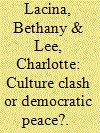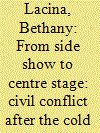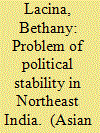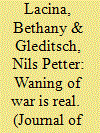| Srl | Item |
| 1 |
ID:
120976


|
|
|
|
|
| Publication |
2013.
|
| Summary/Abstract |
We extend the logic of the democratic peace to query whether information about a foreign country's regime type affects US citizens' opinions of that country. We contrast this with the suggestion in other areas of international relations theorizing, such as the "clash of civilizations" thesis and constructivist frameworks, that a country's culture, especially its dominant religious tradition, may be more salient in citizen attitudes toward foreign countries. We designed a survey experiment to test the effects of randomly assigned cues regarding the regime type (democracy/nondemocracy) and religious culture (Islam/Christianity) of a foreign country on respondents' attitudes. Religious cultural cues outperformed regime type cues in determining respondents' perceptions of threat or expressions of trust, but respondents' views did not conform to maximalist claims of either the democratic peace or the clash of civilizations frameworks. These findings suggest that the need for a more synergetic approach to understanding the microfoundations of public foreign policy opinion formation.
|
|
|
|
|
|
|
|
|
|
|
|
|
|
|
|
| 2 |
ID:
073553


|
|
|
|
|
| Publication |
2006.
|
| Summary/Abstract |
A recent article using the new Correlates of War (COW) data on the distribution of interstate, intrastate, and extrastate wars from 1816 to 1997 claims there was a relatively constant risk of death in battle during that time. We show that the authors' information is skewed by irregularities in the COW deaths data, and contest their pessimistic interpretation. Using revised information on battle deaths from 1900 to 2002 we demonstrate that the risk of death in battle by no means followed a flat line, but rather declined significantly after World War II and again after the end of the Cold War. Future users should note that the deaths data collected for the three conflict types by COW are not comparable, and using them as such tends to underestimate the share of fatalities due to major interstate conflicts.
|
|
|
|
|
|
|
|
|
|
|
|
|
|
|
|
| 3 |
ID:
078926


|
|
|
| 4 |
ID:
068872


|
|
|
| 5 |
ID:
052816


|
|
|
| 6 |
ID:
093187


|
|
|
| 7 |
ID:
125145


|
|
|
|
|
| Publication |
2013.
|
| Summary/Abstract |
A number of recent studies argue that there is decline in armed conflict within and between nations. Gohdes and Price run against the grain in arguing that there is no evidence for a decrease in battle deaths in armed conflicts after World War II and that the trend reported in our earlier articles is spurious. However, they do not plausibly justify this thesis. We reexamine the argument for a decline, exploring nonlinearities in the data and potential biases due to measurement error. We find that very strong assumptions must hold in order for measurement errors to explain the trend in battle deaths.
|
|
|
|
|
|
|
|
|
|
|
|
|
|
|
|